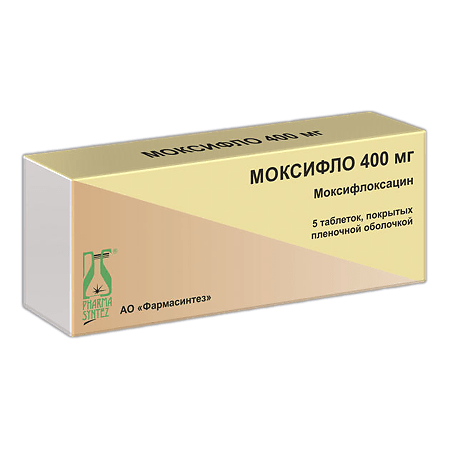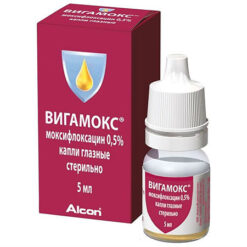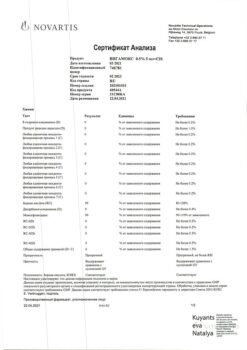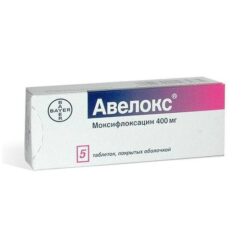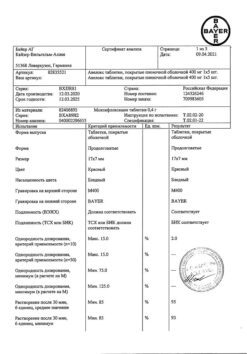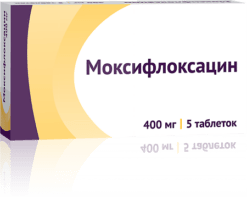No products in the cart.
Description Pharmacotherapeutic group:Antimicrobial agent – fluoroquinolone
Pharmacokinetics:
ATC: J.01.M.A.14 Moxifloxacin
Pharmacodynamics:
Mechanism of action
Moxifloxacin is a broad spectrum bactericidal antibacterial drug, 8-methoxifluoroquinolone.
The bactericidal effect of moxifloxacin is due to the inhibition of bacterial topoisomerases II and IV, which leads to disruption of replication, repair and transcription of DNA biosynthesis of the microbial cell and, as a consequence, to death of microbial cells.
The minimal bactericidal concentrations of moxifloxacin are generally comparable to its minimal inhibitory concentrations.
Resistance mechanisms
The mechanisms leading to the development of resistance to penicillins, cephalosporins, aminoglycosides, macrolides and tetracyclines do not affect the antibacterial activity of moxifloxacin. Cross-resistance between these groups of antibacterial agents and moxifloxacin has not been observed. No cases of plasmid resistance have been observed so far either. The overall incidence of resistance is very low (10-7-10-10).
Resistance to moxifloxacin develops slowly through multiple mutations. Repeated exposure of microorganisms to moxifloxacin in concentrations below the minimum inhibitory concentration (MIC) is accompanied by only a slight increase in the MIC. There are cases of cross-resistance to quinolones. Nevertheless, some gram-positive and anaerobic microorganisms resistant to other quinolones retain sensitivity to moxifloxacin.
It was found that the addition to the structure of the molecule of moxifloxacin of a methoxy group in the C8 position increases the activity of moxifloxacin and reduces the formation of resistant mutant strains of Gram-positive bacteria. The addition of the bicycloamino group at the C7 position prevents the development of active efflux, a mechanism of resistance to fluoroquinolones.
Moxifloxacin in vitro is active against a wide range of Gram-negative and Gram-positive microorganisms, anaerobes, acid-fast bacteria and atypical bacteria such as Mycoplasma spp., Chlamydia spp., Legionella spp. and also bacteria resistant to β-lactams and macrolide antibiotics.
Impact on human intestinal microflora
In two studies conducted on volunteers the following changes in the intestinal microflora were noted after oral administration of moxifloxacin. There were decreased concentrations of Escherichia coli, Bacillus spp., Bacteroides vulgatus, Enterococcus spp., Klebsiella spp. as well as anaerobes Bifidobacterium spp., Eubacterium spp., Peptostreptococcus spp. These changes were reversible within two weeks. Clostridium difficile toxin was not detected.
In vitro sensitivity testing
The spectrum of antibacterial activity of moxifloxacin includes the following microorganisms:
Sensitive | Moderately sensitive | Resistant | |
Gram-positive | |||
Gardnerella vaginalis | |||
| Streptococcus pneumoniae * (including penicillin-resistant strains and strains with multiple antibiotic resistance), as well as strains resistant to two or more antibiotics such as penicillin (MIC ≥ 2 µg/mL), second generation cephalosporins (such as cefuroxime), macrolides, tetracyclines, trimethoprim/sulfamethoxazole/td> | |||
| Streptococcus pyogenes (group A) * | |||
| Group Streptococcus milleri (S. anginosus*, S. constellatus* ,u S.intermedius*) | |||
| Group Streptococcus viridans(S. viridans, S. mutans, S. mitis, S. sanguinis, S. salivarius, S. thermophilus, S. constellatus) | |||
| Streptococcus agalactiae | |||
| Streptococcus dysgalactiae | |||
| Staphylococcus aureus (methicillin-sensitive strains)* | Staphylococcus aureus (methicillin/ofloxacin-resistant strains)** | ||
| Coagulase-negative staphylococci (S. oohnii, S. epidermidis, S. haemolyticus, S. hominis, S. saprophyticus, S. simulans), methicillin-sensitive strains | Coagulazonegative staphylococci (S. cohnii, S. epider midis, S. haemolyticus, S. hominis, S. saprophyticus, S. simulans). methicillin-resistant strains | ||
| Enterococcus faecalis* (vancomycin- and gentamicin-sensitive strains only) | |||
| Enterococcus avium* | Enterococcus faecium* | ||
| Gram-negative | |||
| /td> | |||
| Haemophilus parainfluenzae* | < | ||
| Moraxella catarrhalis (including β-lactamase-producing and non-producing strains)* | |||
| Bordetella pertussis | |||
| Legionella pneumophila | Escherichia coli* < | ||
| Acinetobacter baumannii | Klebsiella pneumoniae* | ||
| Klebsiella oxytoca | |||
| Enterobacter spp. (E aerogenes, E intermedius, E. sakazakii) | |||
| Enterobacter cloacae* | |||
| Pantoea agglomerans | |||
| Pseudomonas aeruginosa | |||
| Pseudomonas fluorescens < | |||
| Burkholderia cepacia | |||
| Stenotrophomonas maltophilia | |||
| Proteus mirabilis* | |||
| Proteus vulgaris | |||
| Morganella morganii | Neisseria gonorrhoeae* | ||
| Providencia spp. (P. rettgeri, P. stuartii) | |||
| Anaerobes | |||
| Bacteroides spp. (B. fragilis*, B. distasonis*, B. thetaiotaomicron*, B. ovatus*, B. uniformis*. B. vulgaris*) | |||
| Fusobacterium spp. | |||
| Peptostreptococcus spp.* | |||
| Porphyromonas spp. | |||
| Prevotella spp. | |||
| Propionibacterium spp. | |||
| Clostridium spp.* | |||
| Atypical | |||
| Chlamydia pneumoniae* | |||
| Chlamydia trachomatis* | |||
| Mycoplasma pneumoniae* | |||
| Mycoplasma hominis | |||
| Mycoplasma genitalium | |||
| Legionella pneumophila* | |||
| Coxiella burnetii | |||
*Moxifloxacin sensitivity has been confirmed by clinical data
**The use of moxifloxacin is not recommended for the treatment of infections caused by S. aureus, resistant to methicillin (MRSA). In case of suspected or confirmed infections caused by MRSA, treatment with appropriate antibacterial agents should be prescribed.
For certain strains, the spread of acquired resistance may vary by geographic region and over time. Therefore, it is desirable to have local information about resistance when testing strain sensitivity, especially when treating severe infections. If patients treated as inpatients have a value of area under the pharmacokinetic concentration-time curve (AUC/MIC90) greater than 125 and the maximum plasma concentration (Cmax)/MIC90 is between 8 and 10, this suggests clinical improvement. In outpatients, the values of these surrogate parameters are usually lower: AUC/MIC90 >30-40.
Parameter (average value) | AUIC* (h) | (Cmax)/ AUIC90 | |
AUIC90 0.125 mg/L |
23.6 | ||
MIC90 0.25 mg/L | 140 | 11.8 | |
MIC90 0.5 mg/L | 70 | 5.9 |
*AUIC – area under inhibitory curve (AUC/MIC90 ratio)
Absorption
On oral administration, moxifloxacin is absorbed rapidly and almost completely. Absolute bioavailability is about 91%. Pharmacokinetics of moxifloxacin when administered in doses from 50 to 1200 mg once or by 600 mg per day for 10 days is linear. The equilibrium state is reached within 3 days. After a single use of 400 mg of moxifloxacin Cmax in blood is reached within 0.5-4 hours and is 3.1 mg/l. After a single oral intake of 400 mg of moxifloxacin Cssmax and Cssmin are 3.2 mg/l and 0.6 mg/l, respectively.
When moxifloxacin is taken with food a slight increase in time to reach Cmax (by 2 hours) and a slight decrease in Cmax (approximately 16%), while the duration of absorption does not change. However, these data have no clinical significance, and the drug may be used regardless of food intake.
Distribution
Moxifloxacin is rapidly distributed in the tissues and organs and binds with blood proteins (mainly with albumin) by about 45%. The volume of distribution is approximately 2 l/kg. High concentrations of the drug, exceeding those in blood plasma, are created in pulmonary tissue (including epithelial fluid, alveolar macrophages), in the sinuses (maxillary and ethmoid sinuses), in nasal polyps, in inflammation foci (in the contents of blisters in skin lesions). In interstitial fluid and saliva moxifloxacin is determined in free form, not bound to proteins, at concentrations higher than in blood plasma. In addition, high concentrations of moxifloxacin are detected in the tissues of the abdominal cavity, peritoneal fluid and female reproductive organs.
Metabolism
Moxifloxacin undergoes biotransformation of the 2nd phase and is excreted by the kidneys and through the intestine both as unchanged and in the form of inactive sulfonic compounds (M1) and glucuronides (M2). Moxifloxacin is not biotransformed by the microsomal cytochrome P450 system. Metabolites M1 and M2 are present in plasma concentrations lower than the parent compound. According to the results of preclinical studies it was proved that the mentioned metabolites have no adverse effects on the body in terms of safety and tolerability.
Elimation
The half-life of moxifloxacin is about 12 hours. Mean total clearance after administration at a dose of 400 mg is 179-246 ml/min. Renal clearance is 24-53 ml/min. This indicates partial tubular reabsorption of the drug. The mass balance of the parent compound and Phase 2 metabolites is approximately 96-98%, indicating no oxidative metabolism. About 22% of a single dose (400 mg) is excreted unchanged by the kidneys, about 26% – through the intestine.
Pharmacokinetics in different groups of patients
Age, sex and ethnicity
When studying pharmacokinetics of moxifloxacin in men and women differences in AUC and Cmax were found in 33%. Absorption of moxifloxacin did not depend on gender. Differences in AUC and Cmax were due to weight differences rather than gender and are not clinically significant. There were no clinically significant differences in the pharmacokinetics of moxifloxacin in patients of different ethnic groups and different ages.
Children
The pharmacokinetics of moxifloxacin in children has not been studied.
Renal failure
There have been no significant changes in pharmacokinetics of moxifloxacin in patients with impaired renal function (including patients with creatinine clearance <30 ml/min/ 1.73 m2) and in patients on continuous hemodialysis and long-term ambulatory peritoneal dialysis.
Hepatic impairment
There were no significant differences in moxifloxacin concentrations in patients with impaired liver function (Child-Pugh grades A and B) compared to healthy volunteers and patients with normal liver function
.
Indications
Indications
Infectious inflammatory diseases caused by microorganisms sensitive to moxifloxacin:
– Uncomplicated infections of skin and subcutaneous structures;
– Community-acquired pneumonia, including community-acquired pneumonia caused by strains of microorganisms with multiple antibiotic resistance*;
– Complicated infections of the skin and subcutaneous structures (including infected diabetic foot);
– Complicated intra-abdominal infections, including polymicrobial infections, including intraperitoneal abscesses;
– Uncomplicated pelvic inflammatory diseases (including salpingitis and endometritis).
– Acute sinusitis;
– Exacerbation of chronic bronchitis.
Streptococcus pneumoniae with multiple antibiotic resistance includes penicillin-resistant strains and strains resistant to two or more antibiotics from such groups as penicillins (at MICâ¥2 µg/mL), second-generation cephalosporins (cefuroxime), macrolides, tetracyclines and trimethoprim/sulfamethoxazole.
Current official guidelines on the use of antibacterials must be taken into account.
Active ingredient
Active ingredient
Composition
Composition
1 tablet contains:
The active ingredient:
moxifloxacin hydrochloride 436.8 mg, equivalent to 400.0 mg of moxifloxacin.
Auxiliary substances:
croscarmellose sodium – 30.0 mg,
lactose monohydrate – 60.0 mg,
Hyprolose – 7.2 mg,
Microcrystalline cellulose – 120.0 mg,
Magnesium stearate – 6.0 mg.
Film coating: hypromellose – 12.0 mg, macrogol 6000-4.0 mg, titanium dioxide – 3.46 mg, iron oxide dye – 0.54 mg.
How to take, the dosage
How to take, the dosage
Recommended dosing regimen for moxifloxacin: 400 mg (1 tablet) once daily for the infections listed above. The recommended dose should not be exceeded. The tablets should be swallowed whole without chewing, with plenty of water, regardless of meals.
The duration of treatment
The duration of treatment is determined by the location and severity of the infection and the clinical effect:
– for exacerbation of chronic bronchitis – 5-10 days;
– for acute sinusitis and uncomplicated skin and subcutaneous structure infections – 7 days;
– in community-acquired pneumonia the total duration of step therapy with moxifloxacin (intravenous injection followed by oral administration) is 7-14 days;
– in complicated infections of the skin and subcutaneous structures the total duration of step therapy with moxifloxacin (intravenous injection followed by oral administration) is 7-21 days;
– In complicated intra-abdominal infections the total duration of sequential therapy with moxifloxacin (intravenous infusion followed by intravenous administration) is 5-14 days;
– in uncomplicated inflammatory diseases of the pelvic organs – 14 days.
Do not exceed the recommended duration of treatment. The duration of treatment with moxifloxacin tablets can be up to 21 days.
Particular groups of patients
There is no need to change the dosing regimen in elderly patients.
The efficacy and safety of moxifloxacin in children and adolescents (under 18 years) has not been established.
Patients with impaired liver function (grade A and B on the Child-Pugh scale) do not require a change in dosing regimen.
In patients with impaired renal function (including severe renal failure with creatinine clearance â¤30 ml/min/1.73 m2) as well as in patients on continuous hemodialysis and long-term ambulatory peritoneal dialysis no change in dosing regimen is required.
In patients of different ethnic groups no change in dosing regimen is required.
Interaction
Interaction
When co-administered with atenolol, ranitidine, calcium-containing supplements, theophylline, cyclosporine, oral contraceptives, glibenclamide, itraconazole, digoxine, morphine, probenecid (the absence of clinically significant interaction with moxifloxacin is confirmed) the dose adjustment is not required.
Drugs prolonging the QT interval
Possible additive effect of QT interval prolongation of moxifloxacin and other drugs that affect QT interval prolongation should be considered.
The co-administration of moxifloxacin and drugs that affect QT interval prolongation increases the risk of ventricular arrhythmias, including polymorphic ventricular tachycardia (torsade de pointes).
Co-administration of moxifloxacin with the following medicines which affect prolongation of the QT interval is contraindicated:
– tricyclic antidepressants;
Warfarin
When combined with warfarin, prothrombin time and other parameters of blood clotting are not changed.
Change in INR value. In patients who received anticoagulants in combination with anticoagulants, including moxifloxacin, there are cases of increased anticoagulation activity of anticoagulants.
Risk factors include the presence of infectious disease (and associated inflammatory process), age and general condition of the patient. Although no interaction between moxifloxacin and warfarin has been identified, patients receiving combined treatment with these drugs should be monitored for INR and the dose of indirect anticoagulants should be adjusted if necessary.
Digoxin
Activated charcoal
In concomitant administration of activated charcoal and moxifloxacin at a dose of 400 mg the bioavailability of the drug is reduced by more than 80% due to the inhibition of its absorption. In case of overdose, the use of activated charcoal in the early stage of absorption prevents further increase in systemic exposure.
Special Instructions
Special Instructions
In some cases hypersensitivity and allergic reactions may develop after the first use of the drug and the physician should be informed immediately. Very rarely, even after the first use of the drug anaphylactic reactions may progress to life-threatening anaphylactic shock. In these cases the treatment with moxifloxacin should be discontinued and necessary medical measures (including anti-shock measures) should be started immediately.
When using moxifloxacin some patients may show prolongation of the QT interval. Moxifloxacin should be used with caution in women and elderly patients. Since women compared to men have a longer QT interval, they may be more sensitive to the drugs prolonging the QT interval. Older patients are also more susceptible to QT interval medications.
Long QT interval prolongation is associated with an increased risk of ventricular arrhythmias, including polymorphic ventricular tachycardia.
The degree of QT interval prolongation may increase with increasing drug concentration, so the recommended dose should not be exceeded. However, in patients with pneumonia the correlation between the concentration of moxifloxacin in plasma and prolongation of QT interval was not observed. None of the 9000 patients who received moxifloxacin had cardiovascular complications and fatalities associated with prolongation of the QT interval. When using moxifloxacin the risk of ventricular arrhythmias may increase in patients with conditions predisposing to arrhythmias. Due to this moxifloxacin is contraindicated in:
– changes in the electrophysiological parameters of the heart, expressed in prolongation of the QT interval: congenital or acquired documented prolongation of the QT interval, electrolyte disorders, especially uncorrected hypokalemia, clinically significant bradycardia; clinically significant heart failure with reduced left ventricular ejection fraction; the presence of a history of rhythm disorders accompanied by clinical symptomatology;
– use with other drugs that prolong the QT interval (see
In other QT interactions (see section “Interaction with other medicinal products”).
Moxifloxacin should be used with caution:
– in patients with potentially proarrhythmic conditions, such as acute myocardial ischemia and cardiac arrest;
– in patients with cirrhosis (because the risk of QT interval prolongation cannot be excluded in this category of patients).
When using moxifloxacin it was reported about the cases of bullous skin lesions such as Stevens-Johnson syndrome or toxic epidermal necrolysis (see section “Side effects”). The patient should be informed that in case of symptoms of lesions of the skin or mucous membranes it is necessary to consult a physician before continuing treatment with moxifloxacin.
Moxifloxacin should be used with caution in patients with myasthenia gravis due to possible exacerbation of the disease.
With the therapy with quinolones including moxifloxacin the tendinitis and tendon rupture may develop, especially in the elderly and patients receiving glucocorticosteroids. Cases have been described that occurred within a few months after completion of treatment. At the first symptoms of pain or inflammation at the site of injury, the drug should be discontinued and the affected limb should be unloaded.
Contraindications
Contraindications
– hypersensitivity to moxifloxacin, other quinolones or any other component of the drug;
– age under 18 years;
– pregnancy and breastfeeding period;
– Any history of tendon pathology, developed as a result of treatment with quinolone antibiotics;
– in preclinical and clinical studies after moxifloxacin administration changes in electrophysiological parameters of the heart were observed, which were manifested by prolongation of QT interval. Due to this fact, the use of moxifloxacin is contraindicated in patients of the following categories: congenital or acquired documented prolongation of the QT interval, electrolyte disorders, especially uncorrected hypokalemia; clinically significant bradycardia; clinically significant heart failure with reduced left ventricular ejection fraction history of arrhythmias, accompanied by clinical symptomatology;
– moxifloxacin should not be used with other drugs that prolong the QT interval (see “Interaction of other drugs that prolong the QT interval”).
– due to the presence of lactose in the drug, its use is contraindicated if there is congenital lactose intolerance, lactase deficiency, glucose-galactose malabsorption;
– due to limited clinical data the use of moxifloxacin is contraindicated in patients with impaired liver function (class C by Child-Pugh classification) and in patients with transaminases elevated more than five times the upper limit of normal.
In CNS disorders (including. suspected CNS involvement) that predispose to seizures and lower the seizure threshold; in patients with psychosis and/or a history of psychiatric illness; in patients with potentially proarrhythmic conditions (especially in women and elderly patients), such as acute myocardial ischemia and cardiac arrest; in myasthenia gravis; in patients with cirrhosis; when concomitantly taken with potassium-lowering drugs; in patients with a genetic predisposition or the actual presence of glucose-6-phosphate dehydrogenase deficiency.
Side effects
Side effects
Data on adverse reactions reported when using moxifloxacin 400 mg (oral, during step therapy [intravenous administration of the drug followed by intravenous administration] and intravenous only) were obtained from clinical trials and post-marketing reports (italicized). Adverse reactions listed in the “frequently” group occurred with a frequency of less than 3%. except for nausea and diarrhea. In each frequency group, adverse drug reactions are listed in descending order of importance. Frequency is defined as follows: frequently (â¥1/100 to <1/10), infrequently (â¥1/1000 to <1/100), rarely (â¥1/10000 to <1/1000). very rarely (<1/10000), frequency is unknown (according to available data it is impossible to determine the frequency).
System-organ classes
(MedDRA)
Often
Infrequently
Rarely
Very rarely
Frequency unknown
Infectious and parasitic diseases
Fungal superinfections
Hematopoietic system disorders
Anemia Leukopenia
/p>
Neutropenia
Thrombocytopenia
Thrombocythemia
Prothrombin time prolongation/increase in international normalized ratio (INR)
Change in thromboplastin concentration
Increased prothrombin concentration/ decreased INR
Immune system disorders
Allergic reactions
Itching
Rash
Hives
Eosinophilia
Anaphylactic/anaphylactoid reactions
Anhyoneurotic edema, including laryngeal edema (potentially life-threatening)
Anaphylactic/anaphylactoid shock (including potentially life-threatening)
Metabolic and nutritional disorders
Hyperlipidemia
Mental disorders
Anxiety
Psychomotor hyperactivity/anxiety
Emotional lability
Depression (in very rare cases, self-harming behaviors such as suicidal thoughts or suicide attempts are possible)
/p>
Depersonalization
Psychotic reactions (potentially manifesting in behavior with a tendency toward self-harm. such as suicidal thoughts or suicide attempts)
Hallucinations
Attention disorder
Disorientation
Nervousness
Memory impairment
Delirium
Nervous system disorders
Headache
Dizziness
Paresthesias/dysesthesias
Disorders of taste sensitivity (including in very rare cases agueusia)
Confusion and disorientation
Sleep disturbances
Tremors
Vertigo
Sleepiness
Hypesthesia
Disorders of smell (including anosmia)
Atypical dreams
Impaired coordination (including gait disturbances due to dizziness or vertigo, in very rare cases leading to injuries from falls, especially in older patients)
Seizures with various clinical manifestations (including “grand mal” seizures) Attention disorders
Speech disorders
Amnesia
Amnesia Peripheral neuropathy and polyneuropathy
Hyperesthesia
/p>
Visual disturbances
/p>
Visual disturbances (especially CNS reactions)
Transient vision loss (especially with CNS reactions)
Hearing and labyrinth disorders
Tinnitus Deterioration of hearing, including deafness (usually reversible)
Cardiovascular abnormalities
Long QT interval in patients with concomitant hypoglycemia
Lengthening of the QT interval
Perception of palpitations
Tachycardia
/p>
Vasodilation
Ventricular tachyarrhythmias
Fainting and increased blood pressure
Decreased blood pressure
Nonspecific arrhythmias
Polymorphic ventricular tachycardia (Torsade de Pointes)
Heart arrest, (mainly in individuals with conditions predisposing to arrhythmias, such as clinically significant bradycardia, acute myocardial ischemia)
Polymorphic ventricular tachycardia (Torsade de Pointes)/p>
Respiratory system disorders. Difficult cage and mediastinal organs
Shortness of breath (including asthmatic conditions )
Gastrointestinal tract disorders
Nausea
Vomiting
p> Abdominal pain
Diarrhea
Limited appetite and reduced food intake
Constipation
Dyspepsia
Meoterism
Gastroenteritis (except erosive gastroenteritis)
Elevated amylase activity
Dysphagia
Stomatitis
Pseudomembranous colitis (in very rare cases associated with life-threatening complications)
Liver and biliary tract disorders
Elevated “hepatic” transaminase activity
Skin and soft tissue disorders
Bullous skin reactions, such as Stevens-Johnson syndrome or toxic epidermal necrolysis (potenially life-threatening)
Musculoskeletal and connective tissue disorders
Arthralgia
Myalgia
Tendinitis
Elevated muscle tone and cramping
Muscle weakness
Tendon ruptures
Arthritis
Gait disturbances due to damage to the musculoskeletal system
The exacerbation of symptoms of myasthenia gravis
Renal and urinary tract disorders
Dehydration (caused by diarrhea or reduced fluid intake)
Kidney function impairment
Kidney failure (due to dehydration, which can lead to renal damage, especially in older patients with pre-existing renal impairment)
Kidney failure (due to dehydration, which can lead to renal damage, especially in older patients with pre-existing kidney function impairment/p>
General disorders and disorders at the injection site
Reactions at the injection/infusion site
General malaise
Nonspecific pain Sweating
Phlebitis/thrombophlebitis at the injection site
Oedema
General disorders and disorders at the injection site
/p>
Reactions at the injection/infusion site
The incidence of the following adverse reactions was higher in the group that received step therapy:
Often: Increased gamma-glutamyl transferase activity
Infrequent: Ventricular tachyarrhythmias, decreased blood pressure, edema, pseudomembranous colitis (in very rare cases associated with life-threatening complications), seizures with various clinical manifestations (including “grand mal” seizures), hallucinations, impaired renal function, renal failure (due to dehydration, which may lead to renal damage, especially in elderly patients with pre-existing renal impairment).
Overdose
Overdose
There are limited data on overdose of moxifloxacin. No adverse effects have been observed when using moxifloxacin in doses up to 1200 mg once and 600 mg for 10 days or more.
In case of overdose the clinical picture should be guided and symptomatic supportive therapy with ECG monitoring should be conducted. The use of activated charcoal immediately after oral administration may help prevent excessive systemic exposure to moxifloxacin in cases of overdose.
Pregnancy use
Pregnancy use
In preclinical studies it was found that a small amount of moxifloxacin is excreted into breast milk. There are no data on its use in women during lactation. Therefore, the use of moxifloxacin during breastfeeding is contraindicated.
Similarities
Similarities
Additional information
| Shelf life | 3 years. Do not use after the expiration date printed on the package. |
|---|---|
| Conditions of storage | In the original package of the manufacturer, at a temperature not exceeding 25 ° C. Store out of the reach of children. |
| Manufacturer | Pharmasintez JSC, Russia |
| Medication form | pills |
| Brand | Pharmasintez JSC |
Other forms…
Related products
Buy Moxiflo, 400 mg 5 pcs with delivery to USA, UK, Europe and over 120 other countries.

